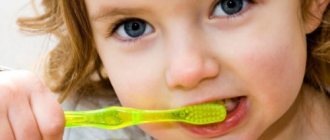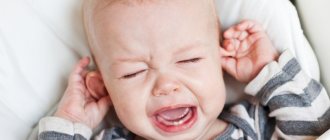Today, Tsefekon suppositories are the most convenient means of reducing high fever. Doctors advise all parents to stock up on this drug. In addition to the antipyretic effect, suppositories have analgesic properties; for this reason, doctors often prescribe this drug to young children to facilitate teething. In our article we will look at the instructions for using Tsefekon D suppositories for children.
Trade name: Tsefekon D.
Latin name: Cefecon D.
Manufacturer: Russia, JSC Nizhpharm.
Official website: www.stada.ru
Normal body temperature in children under one year of age
The thermoregulation system is formed by the end of the baby’s first year of life.
After the mother's womb, the child undergoes adaptation to an external environment that is completely different from the mother's womb. The newborn's body learns to sense different influences, thereby forming a reaction to heat, cold and food. Immediately after birth, the following are considered normal indicators:
—
when measured in the armpit - up to 37.5°C;
—
in the mouth – up to 37.3°C;
—
with rectal measurements – up to 37.7°С
As the thermoregulatory system is established, the indicators approach the usual measurements:
- from 1 to 3 months – 36.8 – 37.7 °C
- from 4 to 6 months – 36.3 – 37.5 °C
- from 7 to 12 months – 36.0 – 37.2 °C
Contraindications
Children under 1 month, hypersensitivity to paracetamol, chronic alcoholism. The drug should be prescribed with caution in diseases of the blood system, severe and liver dysfunction , genetically determined enzymatic absence of glucose-6-phosphate dehydrogenase.
Cefekon D - suppositories during pregnancy and lactation can be prescribed taking into account the benefits and risks for the pregnant woman and the child (fetus). Studies have not established the teratogenic, mutagenic and embryotoxic effects of paracetamol.
Reasons for rising temperature
1.
Eating.
A slight rise in temperature is possible during meals or within 1 - 2 hours after, since the baby spends a lot of strength and energy to produce milk and to digest food. 2.
Overheating.
Parents very often wrap their child up, which is something they shouldn’t do. 3.
Vaccination.
After some vaccinations, a temperature jump may occur. 4.
Teething.
This is the most common cause of increased body temperature in infants due to swelling and inflammation of the gums. 5.
Thirst and dehydration.
It is important that the baby receives enough fluid, especially in the heat or when bottle-fed. Water deficiency is very dangerous for a baby's life. 6.
Infectious and inflammatory diseases. ARVI, colds.
The appearance of the first teeth is a natural physiological process, which at the same time can become a real test not only for the baby, but also for his parents. In many ways, the child’s condition at this moment depends on the positive attitude, support and attention from the parents. However, we should not forget about the whole arsenal of remedies that will help alleviate the unpleasant symptoms of teething and make this stage in life less exciting and painful.
Crying, whims, increased body temperature, lack of appetite, sleepless nights - all these are constant attributes of the period of dentition (teething) in children. Teething is a natural physiological process that begins at the age of 4-7 months and ends by 3 years, when All 20 baby teeth erupt. Despite the experience of generations, in reality, very few parents know what actually needs to be done to make life as easy as possible for both the baby and themselves.
You can recognize the imminent appearance of a baby tooth by the presence of characteristic signs:
The baby's gums become swollen and salivation increases - typically 4 days before the tooth erupts, on the day of teething, and 3 days after, leading to this 8-day window being called the "teething period".[1]
The child makes intense chewing movements with his gums, trying to get rid of the obsessive itching.
Often, children have a runny nose during the dental period. Nasal discharge and a rare wet cough during teething last no more than 3-5 days and are associated with increased mucus secretion and accumulation of saliva in the upper respiratory tract.
Fever during teething can last 1-2 days, and the child’s body temperature does not exceed 37.4-38⁰C. It is caused by the release of biologically active substances in the teeth growth zone and subsides on its own soon after eruption. However, if the child’s body temperature is above 38⁰C or lasts more than 2 days, you should consult a doctor.
Low-grade body temperature (37-38°C) in children SHOULD NOT be reduced with medication. If your baby's body temperature is above 38°C or lasts more than two days, consult a doctor immediately to rule out infection!
Digestive disorders and loss of appetite are also associated with a large volume of saliva secreted, which stimulates intestinal motility.
The child may become restless and irritable.
How to help your baby when teething
:
. At this moment, surround the child with care and affection - pick him up more often or rock him, thereby calming him down.
For itchy gums, use rubber teethers with liquid contents inside. Pay attention to the composition of the product - it should not contain bisphenol A, latex, PVC, phthalates.
Teethers ease the baby's discomfort from the appearance of the first baby teeth, develop thinking, concentrate attention, and improve fine motor skills of the fingers. Use safe “freezing” - before giving the teether to the child, place the
product in the refrigerator for an hour.
If you have already started feeding your baby, use nibblers (a silicone or mesh container with holes in which chewable foods are placed inside), or offer your baby chilled baby puree, yogurt, etc.
Try to learn a few simple techniques for massaging the gums with your finger to further help your child cope with the painful process of dental treatment.
Focus on safety
With all the introductions, it is, as a rule, almost impossible to overcome the pronounced painful symptoms during teething in a child without taking special medications. To help your baby without risking his health, you must follow the recommendations of your pediatrician. In this case, the choice should be made exclusively in favor of natural and safe products.
To alleviate the baby's condition during teething, parents quite often turn to dental gels based on local anesthetics (lidocaine, benzocaine, choline salicylate), unaware of the possible risks.
Local painkillers in gels have a short-term effect (no more than 1 hour), after which the pain returns. Trying to help their child, parents use gels more often than the safe dosing regimen allows. The natural result of excessive use of dental gels in infants is rapidly increasing intoxication, which can manifest itself as life-threatening symptoms, such as impaired breathing, swallowing, heart rhythm, etc.[2][3]
The Food and Drug Administration (FDA) in the United States opposes the use of lidocaine gels[4] for painful teething in children, warning of the risk of serious side effects.
The FDA has also banned the use of benzoin-based gels for teething in children.[5]
Such local anesthetic drugs numb the child’s gums for 10–20 minutes (in the oral cavity they are washed off with saliva and swallowed by the child), and the risks of their use outweigh the potential effect.
To help your baby without risking his health, you must follow the recommendations of your pediatrician. In this case, the choice should be made exclusively in favor of natural and safe products.
An oral solution based on medicinal plants (chamomile, laconosa, rhubarb) ─ Dantinorm Baby ─ is available in the form of individual dosed containers. Each container contains one 1 ml dose of a sterile solution of the drug, which can be easily dropped into the baby's mouth.
Unlike pain-relieving gels, the effect of Dantinorm Baby begins on average in 10 minutes and lasts on average 8 hours, which, when taken 3 times a day, protects the baby from teething symptoms 24 hours a day.[6] Over the many years of use of Dantinorm Baby throughout the world, not a single case of drug overdose has been reported and there have been no reports of side effects associated with its use.[7]
To date, Dantinorm Baby is the only drug used without restrictions for teething in infants, approved by the Russian Dental Association.
Expert opinion: Larisa Kiselnikova, head of the Department of Pediatric Dentistry, Moscow State Medical University named after. Evdokimova, chief freelance pediatric dentist in the Central Federal District of the Russian Ministry of Health.
“The Dental Association of Russia (StAR) constantly monitors the quality of products and medical products used in dental practice. In 2022, a special commission of StAR conducted an expert assessment of the documentation and analyzed foreign and Russian experience in using Dantinorm Baby. Based on the results of the inspection, the commission confirmed its high efficiency and safety.”
[1] Study Macknin ML, Piedmonte M, Jacobs J, Skibinski C. Symptoms associated with infant teething: a prospective study. Pediatrics. 2000: p. 747-752.
[2]Williams, Gary D., et al. "Salicylate intoxication from teething gel in infancy." Med J Aust 194.3 (2011): 146-8.
[3] https://www.gastroscan.ru/literature/authors/7390
[4]https://www.fda.gov/drugs/drug-safety-and-availability/fda-drug-safety-communication-fda-recommends-not-using-lidocaine-treat-teething-pain-and-requires #:~:text=In%20addition%20to%20causing%20death,or%20it%20is%20accidentally%20swallowed.
[5]https://www.fda.gov/news-events/press-announcements/fda-takes-action-against-use-otc-benzocaine-teething-products-due-serious-safety-risk-lack-benefit
[6] Kazyukova T.V., Ilyenko L.I., Kotlukov V.K. Duration and effectiveness of various medications for pathological symptoms of dentition in infants. Pediatrics. 2019; 98 (2): 133-140.
[7] Instructions for the drug Dantinorm Baby.
How to measure a child's temperature
It is more correct to perform thermometry in a calm, preferably sleepy state.
The baby should be exposed or left only in a light vest. The duration of the procedure depends on the type of thermometer. Types of thermometers:
1.
Mercury thermometer.
This is the most accurate device. Measurements are taken in the armpit for 10 minutes, in the mouth and anus for 5 minutes. 2.
Electronic thermometer.
It is known for its fast measurement, and some models have a function to save the last result, which makes it possible to monitor temperature dynamics. 3.
Infrared thermometer.
It is easy to use. They need to swipe their forehead and get the exact numbers. There is also an ear model of such a thermometer, but it will show an unreliable result in case of inflammation of the auricle. 4.
Non-contact thermometer - for measuring without touching.
It is optimal for use in infants, especially during sleep. 5.
Dummy thermometer. A device for babies sucking a pacifier. The result will appear on the screen in just one minute.
Composition and type
The group of non-narcotic analgesics includes cefekon for children. The drug is produced in the form of white torpedo-shaped suppositories. This simplifies the process of using them. Some manufacturers may have a slightly creamy tint. Candles are sold in film blisters of 5 pieces. Two pieces fit into a cardboard box. Suppositories always come with instructions.
Cefekon d contains paracetamol in various quantities: 50, 100 mg, 250 mg. Thanks to this, you can choose exactly the medicine to use. An auxiliary substance that allows rectal suppositories to be given the desired shape is solid fat.
What temperature should be lowered in infants?
There are two types of fever - red and white.
With red hyperthermia, the child’s skin is pink, the palms and soles are warm, and the child’s behavior is normal. The temperature drops easily. With white fever, peripheral vascular spasm occurs. The skin turns pale, the arms and legs are cold. Body temperature can reach high values. The temperature is not going well. This condition is very life-threatening and often causes seizures. Therefore, with white fever, you need to bring down the temperature from 38.0°C. And if it’s towards night, and the temperature is clearly rising, then it’s better even with 37.8°C.
For red hyperthermia, in addition to antipyretic drugs, physical cooling methods should be actively used (wiping the baby’s back, tummy, legs and arms with a towel dipped in warm water).
With white hyperthermia, you need to act differently. First of all, you need to warm the child by rubbing the surface of the body with your hands. You can resort to physical cooling methods only after the skin has become pink and warm.
What to do with high values
1.
Maintain a favorable temperature in the room of 20 - 22°C and ventilate more often.
2.
Dress the child in light clothing.
3.
Drink plenty of warm drinks (breast milk, water).
If the baby is more than 6 months old, then give compote, herbal tea, fruit juice. 4.
Avoid active games.
5.
If the temperature rises significantly, you need to give an antipyretic drug based on paracetamol (Efferalgan, Panadol suspensions, Cefekon suppositories) or ibuprofen (Nurofen suspension).
Terms of use
Tsefekon are candles for children. They are used rectally only as prescribed by a doctor. The drug is prescribed with special caution for up to a year. Suppositories should not be divided to obtain the required dose.
Before administration, it is necessary to cleanse the rectum with an enema. Suppositories can also be administered after the child has had a natural bowel movement. The dose is calculated individually. The age and weight of the child are taken into account.
It is allowed to use 10-15 mg of the active component of the drug per 1 kg of weight. The daily dose should not exceed 60 mg/kg. Repeated use is allowed after at least 6 hours. When deciding to take the drug against the background of impaired renal function, the time interval between taking the drug is increased to 8 hours.
Cefekon suppositories for children can be used to reduce fever for 3 days, and for pain relief – for 5 days. Extension of the period of use of the drug is possible only after consultation with a doctor. Additionally, it will be necessary to monitor blood counts.










